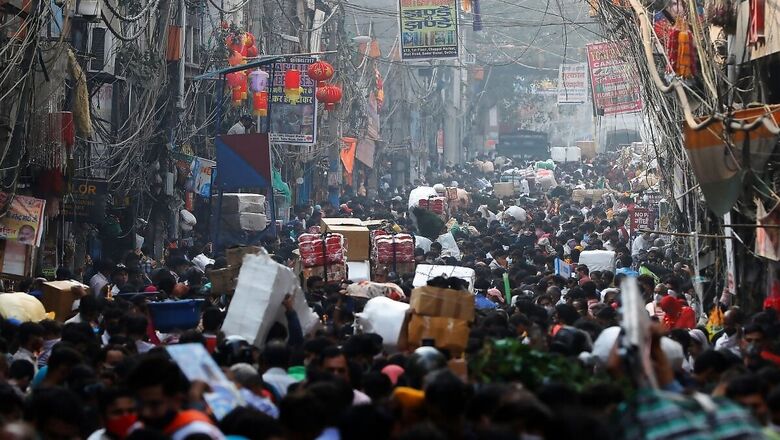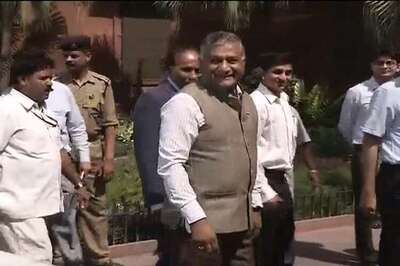
views
As the national capital continues to see a worrying amount of Covid-19 deaths and cases, Delhi Health Minister Satyendar Jain spoke to CNN-News18 on Saturday on the mortality rate, mask fines, and the hopeful time period by which the situation could become better. Delhi recorded 5,879 fresh Covid-19 cases on Saturday and a positivity rate of 12.90 per cent, while 111 more fatalities pushed the death toll to 8,270, authorities said.
Edited excerpts from the interview:
Q) Will the Rs 2,000 fine will be applicable to those driving alone in their own cars?
If you are stepping out of the house, wear a mask. Please don’t step out of the house without wearing a mask. Make a rule for yourself. Make it a habit – just as you put on your shorts, just as those who use spectacles put on their glasses, the moment you step put of the house, put on your mask.
Q) Despite the Delhi Chief Minister clarifying that there would be no lockdown, there is a rumour that 12 markets may be shut down?
These are just rumours. Why comment on rumors? Rumors are not worth commenting upon.
Q) Is there any plan on targeted shutdown of markets in the capital?
Right now, we are keeping a close watch on the level of crowding, whether people are abiding by the rules. There was a complaint that people are not wearing masks. Now that we have increased the fine to Rs 2,000, there should be a positive effect. We are watching the situation and will take decisions accordingly.
Q) Apart from ensuring that people in market wear masks, how will you ensure that they maintain social distance as well?
You have to make an effort to keep the maximum distance possible. For instance, if you are traveling in a car, you can keep distance that your car allows, however, when you step out in the open, do maintain ‘do gaz ki doori’.
Q) Talking about latest Covid-19 figures, even though the numbers of cases have come down, the number of deaths have gone up again.
Yesterday, we got 6,608 cases while the positivity ratio was 10.59% . The number of cases are slowly coming down, and so is the positivity rate. However, I must clarify that weekly average is a better indicator. If you go by each day, some day the number may be up, on another day, the number may be down. But the weekly average is doing down. Today is the sixth day, both in terms of numbers and also the percentages.
Q) But won’t the picture change when Delhi starts testing more than a lakh samples per day, and the cases start spiralling again?
The positivity ratio is more important than numbers. Positivity ratio was above 15% which has now declined to 10.59%. There is a 4% difference , it is not a swing of 1% on some days. So we can definitely say that it has slowly started to climb down.
Q) Then what is the reason for so many people losing their lives? What is the government doing to bring down the mortality rate?
The death rate in Delhi is 1.58 % which is close to the national average. In June, the average was 3.5% to 4% . Over the period since June, this has started declining. It is a dangerous disease. There is a need to fear it. It’s not as if the disease is not leaving its mark. Approximately 1.5% of those infected with Covid are dying. That is unfortunate.
At our level, we have made multiple teams and these teams are checking all protocols. They are visiting government hospitals, as well as private hospitals. And we are monitoring each aspect very closely. For instance, we are monitoring closely those in home isolation. We have launched an app – Jeevan App. While in home isolation, in case you have to visit the hospital, you can use this app. You can go to the hospital and return home, free of cost.
We are monitoring each minute aspect in our effort to save a life.
Q) Delhi’s mortality rate in the past ten days was lower than 1%. By when will we reach that situation again?
On where the mortality rate is concerned, you have to watch it over for longer durations and not one or two days. This has to be thought of in a long term – one month, two months, three months. Since March till now, the mortality rate is 1.58% . When the long term mortality rate was 3.5%, it slowly came down to 3%, 2.5%, 2% and now it is at 1.58%.
Q) Looking ahead, what will be the priority of your government to contain the disease – so that it does not spread and we don’t see another wave?
Now,the government is trying to trace each person who may be Covid-19 positive. Delhi is testing most aggressively in the entire country. Our per million average testing is three times the national average and we are increasing that even further. We are conducting 60,000 tests daily and now we have a target of one lakh tests per day. We will try to reach the one lakh mark. Our effort will be to trace each person who may be positive. There are some places which are not testing because of the possibility of embarrassment with numbers. But we are testing without bothering about numbers. If found positive, we can isolate and check further spread. So the most important thing is to test, then trace contacts and isolate – whether at home or in hospitals.
In containment zones, in high risk areas, we are conducting door to door survey. It should not be that someone is at home, has symptoms and has ignored symptoms or is not even aware of them.
Additionally, there are many symptoms. It is not a specific symptom – it is not as if you will definitely get fever and only then you will get to know. This is the reason why we are conducting a door-to-door survey. The aim is to scan well so that we don’t miss out anyone.
Q) Since projections were already available, Niti Aayog had said that in the worst case scenario, cases could spiral to 15,000 a day. Has there been a delay on the part of your government in reacting to the situation? In increasing the number of beds in hospitals or in warning citizens?
Never has there been a time when less than 7,000 to 8,000 beds were not available. Even today, 7,059 beds are available. Please find out, whether in any other city in our country, even half the number of these beds are available for treatment of Covid patients. The Delhi government has been aggressive. It also depends on occupancy. Earlier, the occupancy was about 25% to 30% . Now, the occupancy is close to 50%. When the occupancy is 25%, there is no reason to further augment capacity.
Two days earlier, we gave orders to private hospitals and have added 2,644 beds. We are increasing the number of beds even within government hospitals, we are also increasing the number of ICU beds. I another two days, the situation will be quite comfortable. Even now, approximately 50% of the beds are available.
Q) By when do you think the situation will take a definite turn for the better? One week or two?
Right now, I can say that it appears that there is a downtrend. The positivity rate has come from from 15% on November 7 to 11% now. So there is a downtrend. After one week, we can confirm that it is going down.
But, look at the manner in which the virus is behaving. Look at what is happening in Europe – it is recording 3,00,000 lakh plus cases per day, which had not happened before. Every day, across the world, more than 10,000 deaths are being recorded per day. So there is no way of telling definitely how this virus will behave, how long it will stay.
The Spanish flu in 1018, that was a hundred years ago, lasted for two years from 1918 to 1920 – sometimes it would subside and then it would go up again. Only after the vaccine comes, would we able to tell how this can be contained.
Q) Who will your government prioritize when it comes to distribution of vaccines? Have there been any discussions within the government regarding this?
Let the vaccine come first. Right now, there is no certainty about when will we get the vaccine. Some say it will come in January, some say, it will be later. Everyone should get it.
Read all the Latest News, Breaking News and Coronavirus News here




















Comments
0 comment